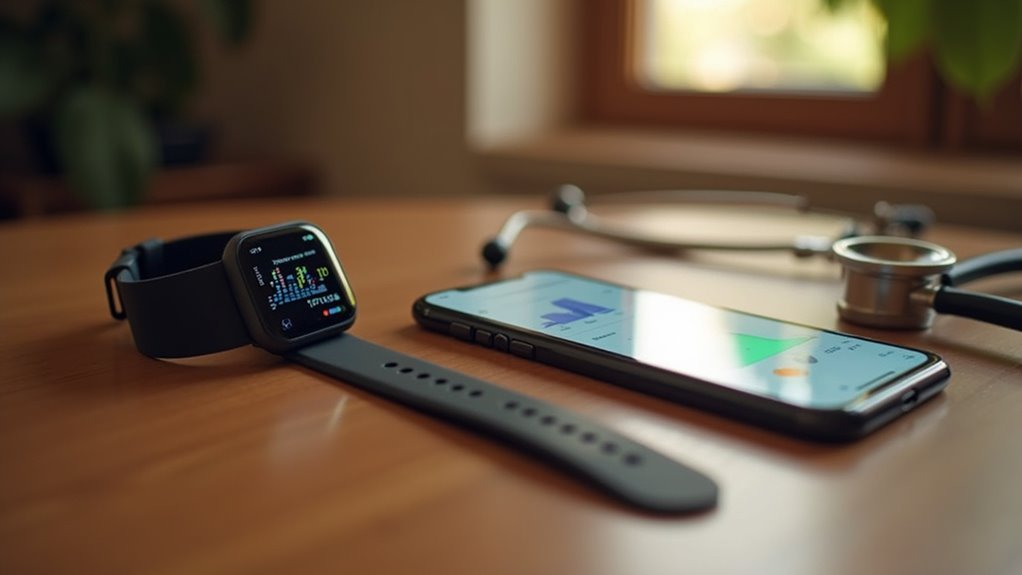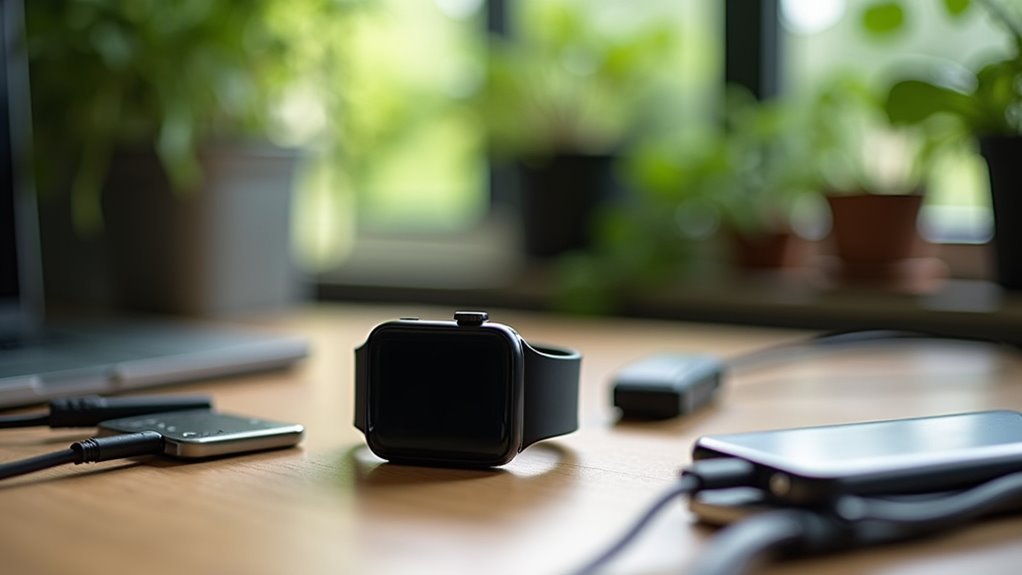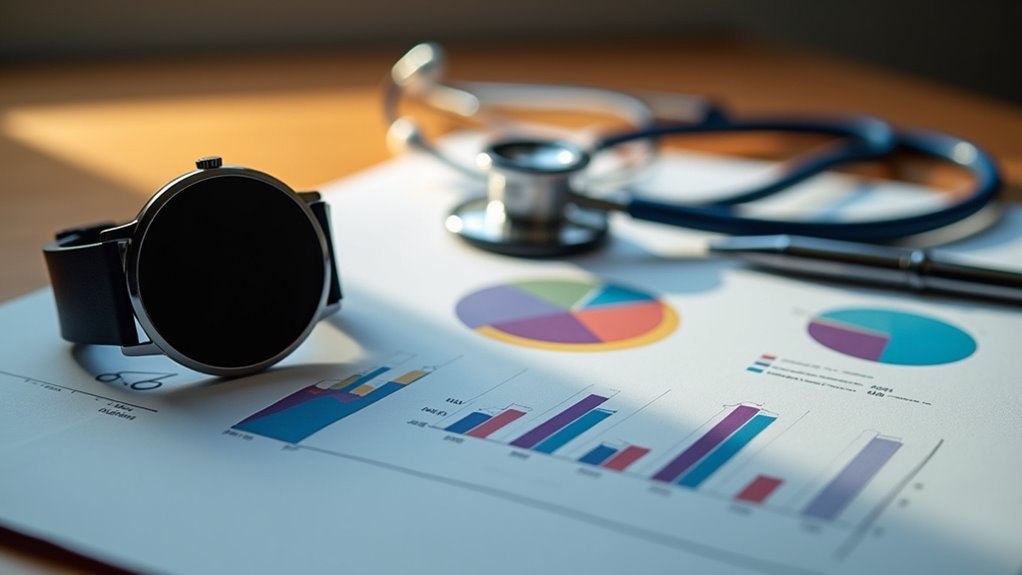You can export blood oxygen data through seven key methods: iOS Health app’s built-in XML export feature, manufacturer apps like Garmin Connect and Samsung Health that offer CSV and JSON formats, third-party health aggregation services, cloud-based synchronization platforms for real-time data transfer, manual spreadsheet entry tools, automated API integrations for seamless data flow, and direct USB or Bluetooth device transfers. Each method offers different levels of complexity, automation, and data format options to match your technical expertise and analytical needs.
Built-In Health App Export From Ios Devices

When you need to export blood oxygen data from your iPhone or iPad, the built-in Health app provides a straightforward but extensive solution.
The Health app offers a simple yet comprehensive approach to exporting your blood oxygen measurements from iOS devices.
You’ll start by opening the Health app and tapping your profile picture to access export options. Select “Export All Health Data” to begin the thorough export process.
The Health app exports everything as XML files within a ZIP archive, including your blood oxygen measurements alongside other health metrics like electrocardiograms and workout routes.
However, you can’t cherry-pick specific data types – it’s an all-or-nothing export.
While this method captures your blood oxygen data, the resulting XML files are complex and difficult to read without additional software, making data analysis challenging for most users. The exported files can be exceptionally large file sizes, often reaching 90+ megabytes or more depending on your health data history.
Wearable Device Manufacturer Apps and Platforms
You’ll find that wearable device manufacturers offer their own dedicated apps and platforms with built-in export capabilities that often surpass what’s available through generic health apps.
These manufacturer-specific solutions typically provide multiple data format options like JSON, CSV, and PDF reports, giving you flexibility in how you access and analyze your blood oxygen readings. Advanced platforms utilize newline delimited JSON formatting to enable efficient processing of large datasets containing blood oxygen measurements and related health metrics.
Most importantly, these platforms include cross-platform integration features that let you seamlessly connect your data with third-party research tools, healthcare systems, and analysis software.
Direct App Export
The most straightforward method for accessing your blood oxygen data involves using the manufacturer’s dedicated app that came with your wearable device.
These apps provide direct access to your health metrics through intuitive interfaces designed specifically for your device’s capabilities.
Popular manufacturer apps offer varying levels of blood oxygen export functionality:
- Garmin Connect – Exports pulse oximetry data in multiple formats with thorough tracking
- ZeppLife – Manually exports blood oxygen data from Xiaomi Mi Band devices
- Samsung Health – Provides export options for various health metrics including SpO2
- Huawei Health – Offers export capabilities through their dedicated health platform
- Fitbit App – Exports extensive health data, though blood oxygen measurement is indirect
You’ll typically find export options in your app’s settings or profile sections, where data is organized into clear categories for easy navigation. Modern wearable devices increasingly utilize reflective oximeters for convenient blood oxygen monitoring, as these sensors can be placed directly on the wrist surface for easy integration into watch-type devices.
Data Format Options
Once you’ve located the export feature in your device’s app, you’ll encounter several data format options that determine how your blood oxygen information gets packaged for download.
CSV format works best if you’re planning to analyze data in spreadsheets or statistical software, as it’s universally supported and creates clean columns for timestamps, SpO2 values, and measurement duration.
JSON format suits more complex analysis needs since it handles hierarchical data structures and includes detailed metadata alongside your readings.
Some manufacturers like Garmin offer proprietary summary formats with unique participant identifiers and specialized fields for on-demand versus continuous readings.
These formats often include ISO 8601 timestamps and can batch export data across multiple days or participants for research purposes. For enhanced data security, ensure your exported files are stored on medical-grade servers that meet industry certification standards.
Cross-Platform Integration Features
Modern wearable manufacturers have built sophisticated cross-platform ecosystems that let you seamlessly move your blood oxygen data between devices, operating systems, and third-party applications.
Whether you’re using iOS or Android, you’ll find extensive web-based dashboards that provide browser access to your SpO2 exports. Apple Health data works natively on iOS but exports easily for cross-platform use, while Samsung Health and Fitbit integrate smoothly with Android systems.
Key cross-platform integration features include:
- Universal web access – All major platforms offer browser-based data management
- Standard export formats – CSV, JSON, and XML support across different systems
- Multi-device synchronization – Access your data from phones, tablets, and computers
- Third-party app compatibility – Integration with research platforms and health management tools
- Automated data pipelines – Set up continuous data flows to external monitoring systems
Professional research platforms enable customizable sampling rates for blood oxygen monitoring, allowing researchers to capture SpO2 data at intervals ranging from 10 seconds to 60 minutes depending on study requirements.
Third-Party Health Data Aggregation Services
When you’re choosing a third-party health data aggregation service for blood oxygen exports, you’ll need to evaluate platforms based on their integration capabilities, data format compatibility, and user interface design.
These services must seamlessly connect with your wearable devices and existing health systems while maintaining robust encryption and HIPAA compliance standards. Modern healthcare organizations are increasingly recognizing that advanced analytics and AI integration are essential for maximizing the value of collected health data and improving patient outcomes.
You’ll want to prioritize platforms that offer granular privacy controls and transparent data handling policies to protect your sensitive health information.
Platform Selection Criteria
Selecting the right third-party health data aggregation service requires careful evaluation of multiple critical factors that’ll directly impact your blood oxygen data export capabilities.
You need to assess each platform’s technical strengths and limitations to guarantee seamless integration with your existing systems.
Consider these essential selection criteria:
- Security compliance – Verify HIPAA adherence and robust data protection standards
- EHR compatibility – Confirm support for your electronic health record systems and interoperability standards
- Data processing capacity – Evaluate the platform’s ability to handle large volumes efficiently
- Analytics capabilities – Look for predictive analytics and machine learning integration features
- Implementation costs – Analyze pricing models, setup time, and total ownership expenses
Prioritize platforms offering real-time data access and thorough technical support. Strong vendor support is crucial for operationalizing data insights and achieving meaningful patient outcomes beyond just having advanced technological capabilities.
Data Integration Capabilities
Although third-party health data aggregation services excel at consolidating information from multiple sources, their integration capabilities directly determine how effectively you’ll access and utilize your blood oxygen data.
You’ll find that top platforms deploy robust data ingestion processes with near real-time capabilities, achieving 88% deployment rates among leading vendors. These services pull data from diverse healthcare sources including EHRs, medical claims, and pharmacy records, processing hundreds of millions of clinical patient records.
You’ll benefit from extensive data cleaning and normalization capabilities that 80% of surveyed clients deploy to manage healthcare dataset inconsistencies.
The platforms emphasize adherence to interoperability standards like HL7 FHIR, facilitating seamless data exchange across disparate healthcare IT systems while reducing manual reconciliation efforts through common data standards. Leading solutions integrate disparate data across the healthcare ecosystem to reduce report building time and costs.
Privacy and Security
While third-party health data aggregation services offer powerful integration capabilities, you’ll need to prioritize robust privacy and security measures when handling sensitive blood oxygen data.
Your data protection strategy must include extensive safeguards that meet regulatory requirements while maintaining operational efficiency. Essential security measures include:
- HIPAA compliance verification – Confirm all vendors meet healthcare data protection standards
- Business Associate Agreements (BAAs) – Establish legal frameworks for PHI handling
- End-to-end encryption – Protect data during transfer and storage phases
- Role-based access controls – Limit data access to authorized personnel only
- Regular security audits – Identify and address potential vulnerabilities proactively
You’ll also need to conduct thorough due diligence on service providers, implement data loss prevention tools, and maintain incident response plans to handle potential breaches effectively. Healthcare organizations face increasing cyberattack complexity that specifically targets sensitive patient information like blood oxygen readings.
Cloud Storage and Synchronization Solutions
When you’re looking to export blood oxygen data efficiently, modern cloud storage and synchronization solutions offer the most robust approach for continuous monitoring and data management.
IoT-enabled systems using pulse oximeters and microcontrollers like ESP-32 transmit your SpO2 data wirelessly to cloud platforms in real time. This eliminates manual data collection while providing centralized access for healthcare professionals.
Professional platforms like Nonin’s nVISION integrate seamlessly with compatible devices, offering customizable analytics and automated report generation.
Mobile apps using Bluetooth Low Energy sensors stream data directly to cloud databases, enabling live visualization and long-term storage.
These solutions reduce administrative overhead, support multiple simultaneous devices, and facilitate remote monitoring outside clinical settings while ensuring secure backup and interoperability with electronic health records. The cross-platform interface design accommodates healthcare workers with varying levels of technology experience.
Manual Data Entry and Spreadsheet Tools

Not everyone has access to sophisticated cloud-based systems or automated data collection tools, making manual data entry and spreadsheet applications a practical alternative for blood oxygen monitoring.
When you’re manually entering data, you’ll appreciate these key benefits:
- Immediate flexibility – You can review and correct entries in real-time
- Zero software costs – No additional expenses for specialized applications
- Universal compatibility – Works with any oximeter model regardless of connectivity
- Enhanced security control – You maintain complete oversight of sensitive health data
- Custom organization – Arrange data exactly how you need it
You can use Microsoft Excel, Google Sheets, or LibreOffice Calc to organize your readings effectively. When recording SpO2 measurements, ensure data points are collected during stable plateaus to avoid including transient response variations that could affect the accuracy of your exported health records.
While manual entry takes more time, it’s cost-effective and gives you direct control over data accuracy and formatting preferences.
API Integration and Automated Export Scripts
For users managing large datasets or multiple devices, API integration transforms blood oxygen monitoring from a manual task into an automated workflow.
You can access SpO2 data through APIs from Oura, Withings, Garmin, Google, Apple, and Samsung, enabling seamless integration across platforms.
You’ll write scripts in Python or JavaScript to automate data export, using scheduling tools like cron jobs for regular intervals.
These scripts process and format data while handling API rate limits and security requirements. APIs provide centralized data management, automated analysis capabilities, and enhanced privacy controls.
However, you’ll face challenges including API complexity, data consent requirements, and security risks.
You must use HTTPS protocols, comply with HIPAA or GDPR regulations, and regularly monitor performance to maintain efficient, secure data exports. The PPG technology uses infrared and red light reflected onto the skin to accurately determine oxygen saturation levels across different wearable devices.
Direct Device File Transfer Methods

While API integration offers sophisticated automation capabilities, many users prefer the simplicity and reliability of direct device file transfers.
These methods provide immediate access to your blood oxygen data without requiring complex programming knowledge or third-party services.
You’ll find several straightforward options for transferring your pulse oximetry data:
- USB cable transfer – Connect directly to your PC/Mac for stable, high-speed data transfer using manufacturer software
- Bluetooth export – Wirelessly send CSV, XML, or PDF files to paired devices for convenient mobile access
- SD card extraction – Remove storage cards from medical devices and copy files directly to computers
- Companion apps – Use manufacturer-developed applications for guided export with visualization tools
- Email export – Send data files directly from compatible devices or apps
Since pulse oximetry serves as the 5th vital sign in clinical settings, ensuring reliable data export methods becomes essential for comprehensive patient monitoring and record-keeping.
Frequently Asked Questions
How Long Can Blood Oxygen Data Be Stored on Wearable Devices?
You’ll find storage varies considerably by device. Wellue WearO2 stores 40 hours total, while smartwatches like Apple Watch sync to phones with limited local storage. Most devices prioritize cloud syncing over onboard storage.
Are Blood Oxygen Readings Accurate Enough for Medical Diagnosis Purposes?
You shouldn’t rely solely on blood oxygen readings for medical diagnosis. They’re generally accurate within 2-4%, but limitations exist with dark skin pigmentation, nail polish, and motion affecting results.
What File Size Limits Exist When Exporting Large Blood Oxygen Datasets?
You’ll encounter Excel’s 1,048,576 row limit requiring dataset splitting. Large file sizes can be reduced using compressed formats like MDF4.1 or MAT files, and you can segment data into manageable time periods.
Can Exported Blood Oxygen Data Be Imported Back Into Health Apps?
Yes, you can import exported blood oxygen data back into health apps using third-party tools that convert XML files to compatible formats like CSV or JSON for seamless integration.
Do Insurance Companies Accept Exported Blood Oxygen Data for Health Claims?
Insurance companies rarely accept exported blood oxygen data from wearables for direct health claims. You’ll typically need clinical blood gas tests instead. However, insurers increasingly use your wearable data for risk assessment and fraud prevention purposes.
In Summary
You’ve now got seven solid options for exporting your blood oxygen data, from simple built-in iOS tools to advanced API integrations. Choose the method that best fits your technical comfort level and data needs. Whether you’re tracking health trends, sharing with healthcare providers, or conducting research, these export strategies will help you access and utilize your SpO2 measurements effectively. Start with the easiest option and upgrade as needed.





Leave a Reply